Growing broccoli in your home garden is a wonderful way to enjoy this fresh, cool-weather vegetable.
But to have the best possible success, first you must learn about the ins and outs of broccoli plant care.
This comprehensive guide on how to grow broccoli is perfect for gardeners of any skill level. You’ll learn about timing, location, sun, water, soil, pest control, and so much more.
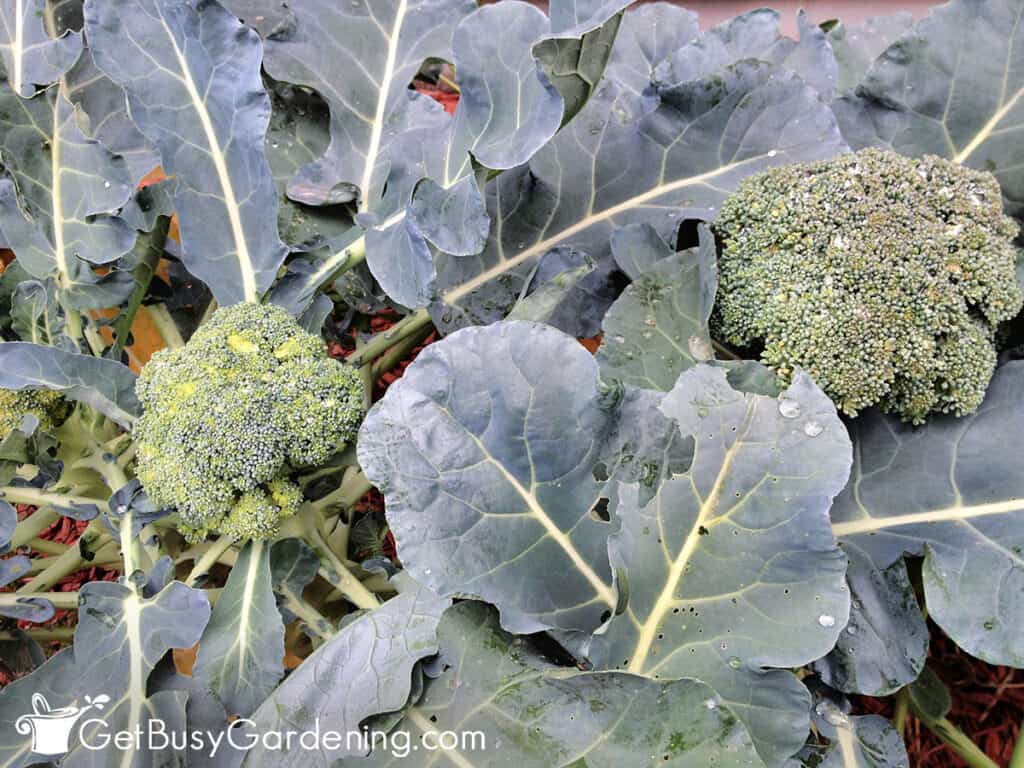
Quick Broccoli Care Overview
| Scientific name: | Brassica oleracea var. italica |
| Classification: | Vegetable |
| Common names: | Broccoli, Calabrese |
| Hardiness: | Biennial |
| Temperature: | 65-80°F (18.3-26.6°C) |
| Flowers: | Yellow flowers, summer |
| Light: | Full sun |
| Water: | Keep soil evenly moist. Never allow it to dry completely |
| Humidity: | Average |
| Fertilizer: | Balanced vegetable fertilizer, spring or fall |
| Soil: | Fast-draining, fertile soil |
| Common pests: | Caterpillars, aphids, stink bugs, whiteflies |
Information About Broccoli
Broccoli (Brassica oleracea) is a cole crop and a member of the Brassicaceae, or mustard, family of vegetables. It’s related to other favorites like cabbage, brussels sprouts, kale, kohlrabi, and cauliflower.
It’s technically a biennial, but most people grow it as an annual. It can keep producing almost year-round, depending on your climate. Eventually it will bloom, set seed, and then die.
The heads, or crowns, are made up of tightly packed clusters of unopened flower buds. They’re typically dark green, but can have hues of blue. There are even heirloom varieties that produce a purple crown.
All parts of the plant are edible, and the main head can range in size from 3-6” depending on the environment, variety, and quality of care.
Different Types
Different broccoli varieties feature varying heat tolerance levels, cold resistance, growth rates, color, and size. All of them require the same care. Here are a few of the most popular options:
- Calabrese – This is the type you’re most familiar with from the grocery store. It’s an heirloom variety that grows well in the fall, and has large heads with plentiful side shoots.
- Early Purple – This fast-growing, cold-tolerant purple heirloom variety is excellent for spring and fall planting, and produces many side shoots after the main harvest.
- Green Goliath – This variety produces large 8-12” green heads, abundant side shoots, and is both heat and cold-tolerant.
- Waltham 29 – This reliable heirloom is drought-tolerant and produces a medium-sized blue-green crown with many side shoots.
How Does Broccoli Grow?
Broccoli grows from the main central stem. Only one large crown will form at the top of each plant.
But most plants will also produce several smaller heads, or side shoots, after you harvest the central one. So you can continue enjoying it all season long.
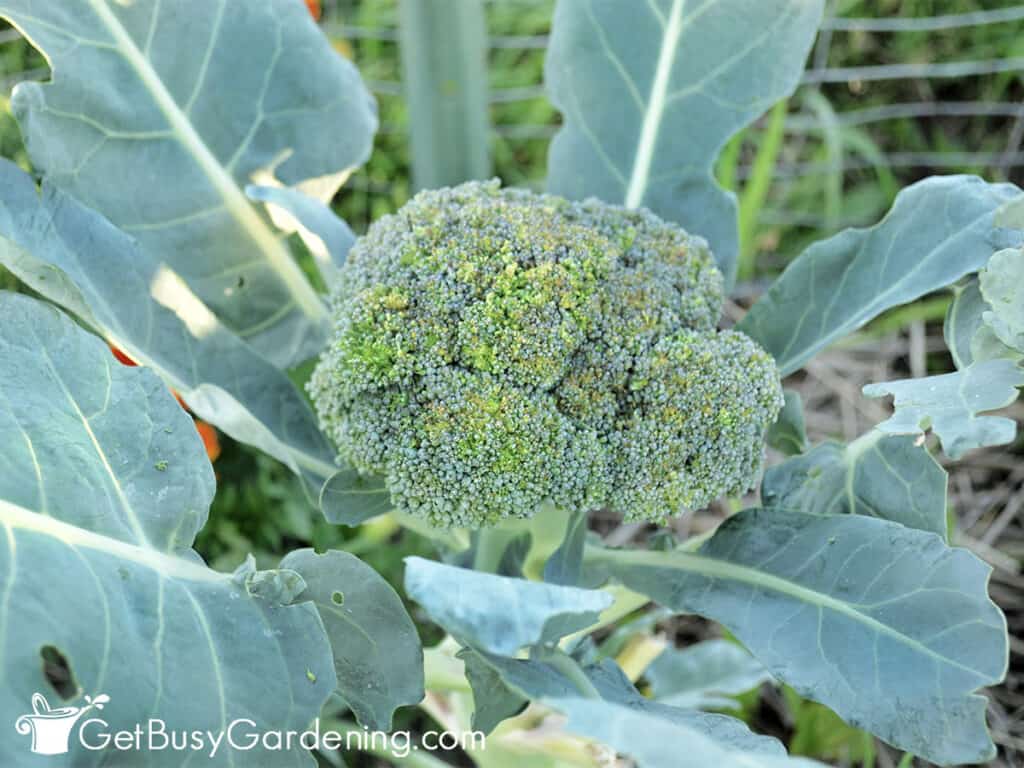
How To Grow Broccoli
Before we get into the specific care instructions, let’s chat about when and where to grow broccoli. Timing and location are keys to success.
Where To Grow Broccoli
You can grow your broccoli in the ground, containers, or raised beds. Pots should be at least 5 gallons with an 18” diameter and drainage holes in the bottom.
In your garden, choose a spot that gets full sun, where the soil is well-draining and fertile.
When To Plant
Broccoli grows best in cooler weather. Plant it as soon as the ground is workable in early spring, or when the ground is at least 40°F (4.4°C), which you can check with a soil thermometer.
Aim for 2-3 weeks before the last frost date for direct sowing, or 6-8 weeks before to start them indoors.
If you live somewhere warm, plant them in the late summer or early fall. The goal is for the crowns to start developing when the temperatures have begun to cool down for autumn.
Related Post: How To Grow Broccoli From Seed & When To Start
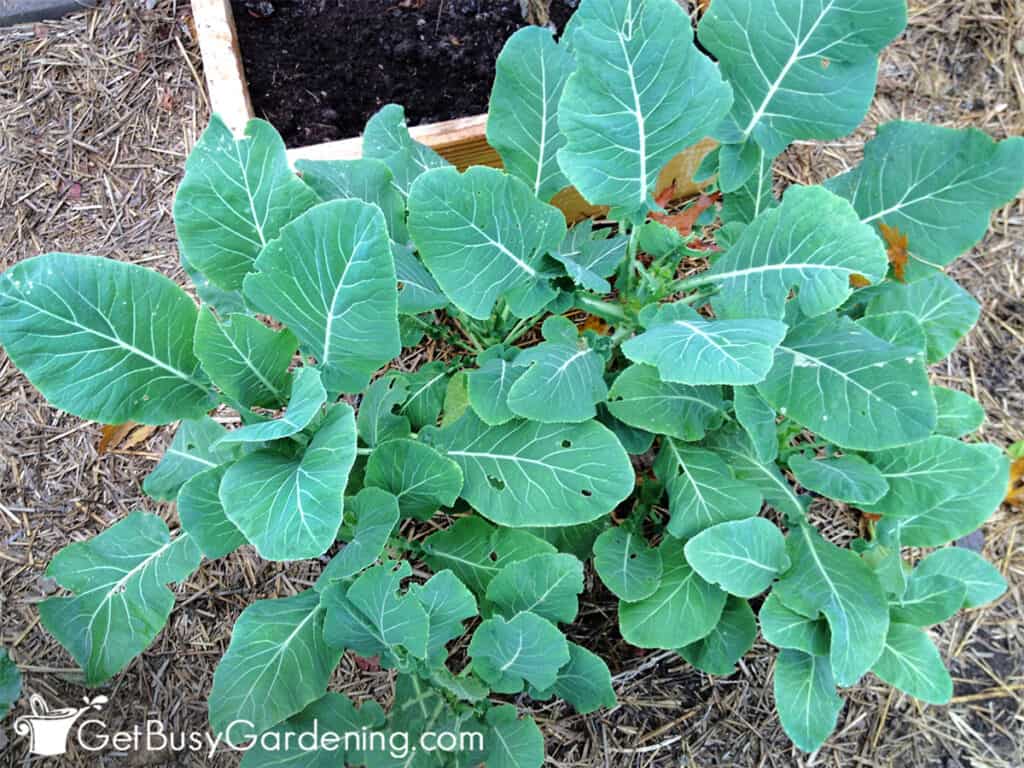
Broccoli Plant Care & Growing Instructions
Now that you know when and where to grow it, let’s talk about how to care for broccoli plants. These tips will help you create an environment where they can thrive.
Sunlight
Broccoli likes a full sun location where it will get 6-8 hours of direct exposure daily. Too little can cause leggy, thin growth and small crowns.
Excess sun, especially during hot weather, causes them to bolt or flower. If you’re expecting a heat wave, use a shade cloth to provide afternoon protection when the sun is most intense.
Water
Keep your plants evenly moist by ensuring they get 1-1 ½ inches of water every week. Without enough, you’ll end up with small, bitter broccoli. Use a moisture gauge to measure how much they’re getting.
It’s also important to only irrigate at the base of the plant. If water sits on the developing crown for too long, it can cause rot.
Temperature
The ideal temperature range for growing broccoli is between 65-80°F (18.3-26.6°C).
Some varieties are more heat tolerant than others, but high temperatures will cause bolting, or flowering, making it bitter and mealy.
Cold won’t bother it until temperatures dip below 26°F (-3.3°C), and persistent freezing weather will eventually kill the plant.
Fertilizer
Broccoli is a heavy feeder and likes lots of nutrients, so you should apply a balanced all-purpose fertilizer throughout the growing season.
Use an organic liquid fertilizer every two weeks, or top-dress with slow-release granules once per month.
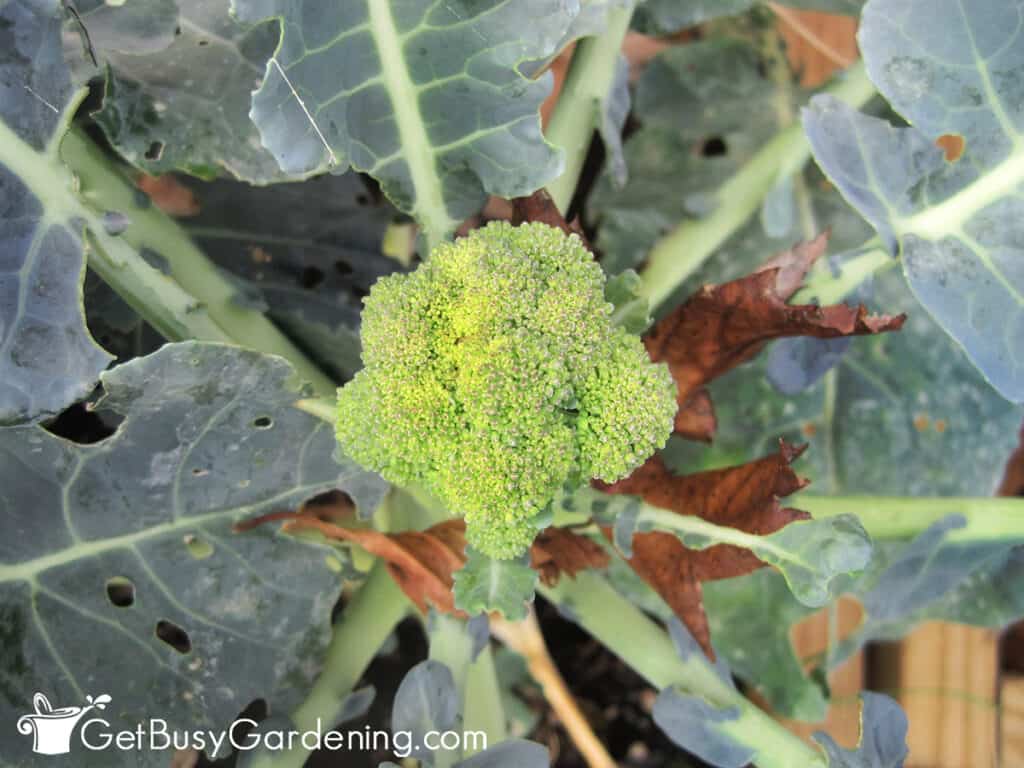
Soil
The best type of soil for growing broccoli is fertile, rich, and well-draining with a pH between 6.0-7.0.
Amend your garden bed with compost to improve drainage and boost nutrition, and add garden lime or acidic fertilizer to adjust the pH if needed. You can test it with a pH probe.
Use a general-purpose potting mix, and amend it with perlite for better drainage in your containers.

Pest Control Tips
The main pests for broccoli plants are 3 types of caterpillars: cabbage worms, diamondback moths, and cabbage loopers. But they can also be affected by aphids, stink bugs, and whiteflies.
Treat small bugs with an insecticidal soap, and hand-pick the larger ones. Floating row covers are a good way to protect young plants from insects, and prevent the moths from laying their eggs.
Disease Control Tips
Diseases like bacterial leaf spot, Verticillium wilt, clubroot, mildew, and white mold can be issues for broccoli. They cause discoloration, stunted growth, and can even kill the plant.
At the first sign of disease, apply an organic fungicide and trim away any infected foliage to stop it from spreading. Clubroot causes wilting and gnarled roots. If this happens to your plant, you must dig it up and destroy it.
Tips For Harvesting Broccoli
It’s essential to harvest your broccoli before the buds turn yellow or start opening. Because that means it’s starting to flower, or bolt, and it causes a bitter and mealy flavor.
When you have a densely packed head with tight clusters of buds, about 50-80 days after planting, it’s time to harvest.
Use a sharp knife or heavy-duty shears to make a diagonal cut through the main stem about 6” below the crown. The diagonal cut prevents water from pooling on the wound, which can cause rot.
Don’t pull the plant though, leave it in so you can continue harvesting the smaller side shoots until the plant begins to die.

Troubleshooting Common Problems
Broccoli can be a fun vegetable to grow, but no plant is problem-free. Use this section to help get your plant back on track if you encounter one of these issues.
No Heads
Either damage, too much shade, or hot temperatures could cause a lack of crown development. Insects can sometimes eat the head, effectively stumping the main stem, which is called blindness. Row covers can help prevent this from happening.
Heat is also a problem, so it’s essential to plant it at the right time, and avoid extreme summer temperatures. Make sure your broccoli is growing in the full sun with 6-8 hours of exposure daily.
Small Heads
Issues like extreme temperatures, lack of nutrients, or too little light can lead to small crowns. Anything outside the ideal range of 65-80°F (18.3-26.6°C) can stall or stunt heads.
Keep them in full sun, and fertilize with a general-purpose liquid every 2 weeks, or add granules once per month to keep the nutrient levels high.
Yellow Leaves
Disease, pests, and overwatering are common reasons for yellow broccoli leaves. Irrigate at the base to prevent water and soil from splashing on the foliage. Keep the soil moist without making it muddy and soggy.
Use row covers and insecticidal soap to stop bugs, and an organic fungicide to prevent the spread of disease.
Holes In Leaves
The number one cause of holes in broccoli leaves is caterpillars. Use a natural insecticidal soap, or hand-pick larger bugs and drop them into a bucket of soapy water.
Bolting
Bolting is another term for flowering. Broccoli will bolt when the temperatures remain above 80°F (26.6°C), or if you leave the mature crown on the stem for too long.
Combat high heat by using shade covers in the afternoon, and planting your broccoli as early as possible. Harvest the heads as soon as they’re fully mature, or at the first sign of yellow, to stop it from going to flower.
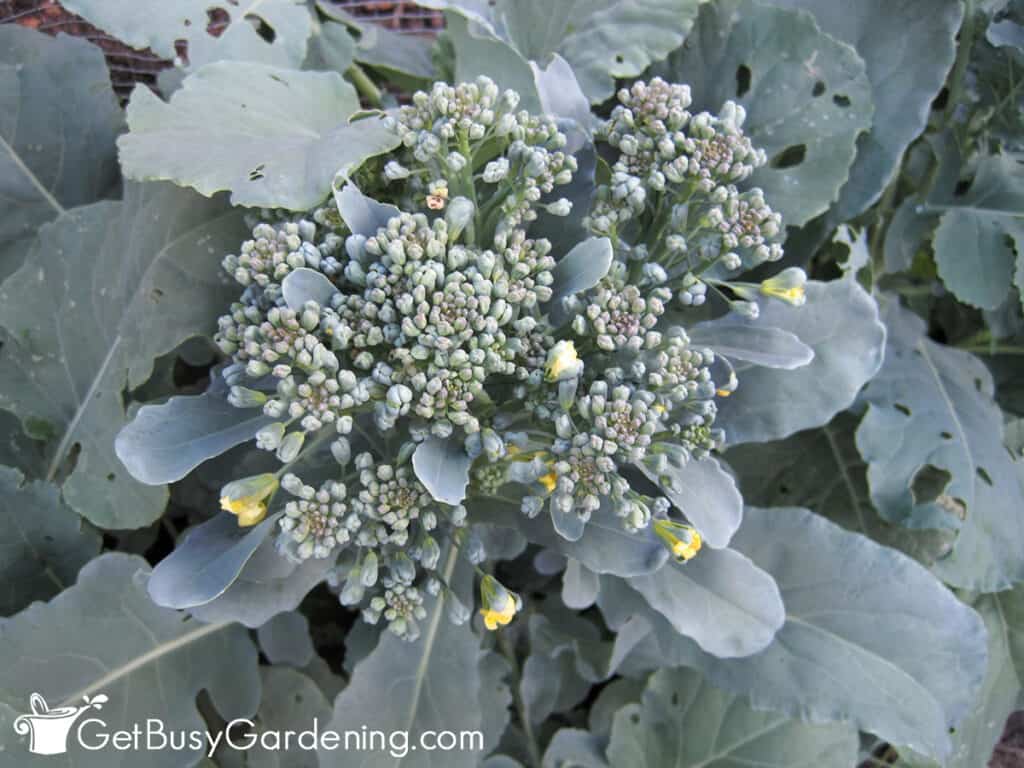
FAQs
Many people find broccoli difficult to grow because of the timing. It does best during cool weather so the head can develop without high heat, which causes it to bolt. It can be easy to grow with correct timing, good soil, proper watering and sunlight, and plenty of fertilizer.
The trick to growing broccoli is knowing when to plant it. Aim for early spring as soon as the ground has thawed, or in the fall when the weather is cool enough so the head can develop without bolting.
Broccoli is a biennial plant that only lives for about 2 years. It produces one central crown, and usually several edible side shoots, until either freezing temps kill it, or high heat causes it to flower and set seeds.
Broccoli can be ready to harvest between 50-80 days after planting, depending on the variety, the environment, and the care you give it as it grows.
If you’d like to learn how to make the most of your space and get as much homegrown food as possible, then my Vertical Vegetables book is perfect! It will teach you all you need to know, has tons of gorgeous photos, and includes 23 DIY projects you can build for your own garden. Order your copy today!
Learn more about my Vertical Vegetables book here.
More About Vegetable Gardening
Share your tips for growing broccoli in the comments section below.
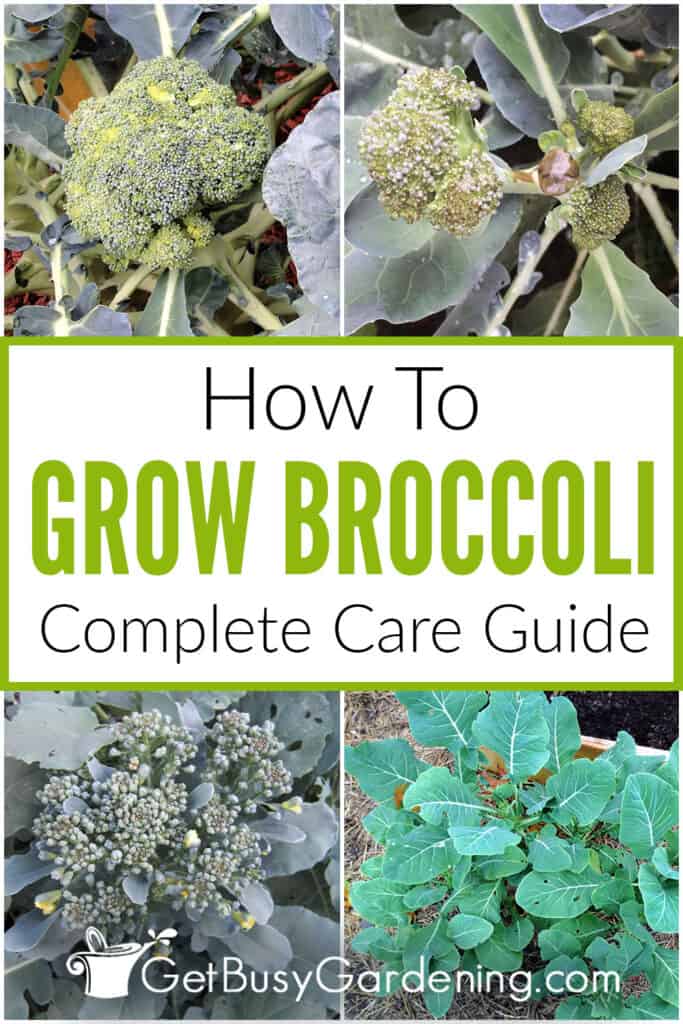
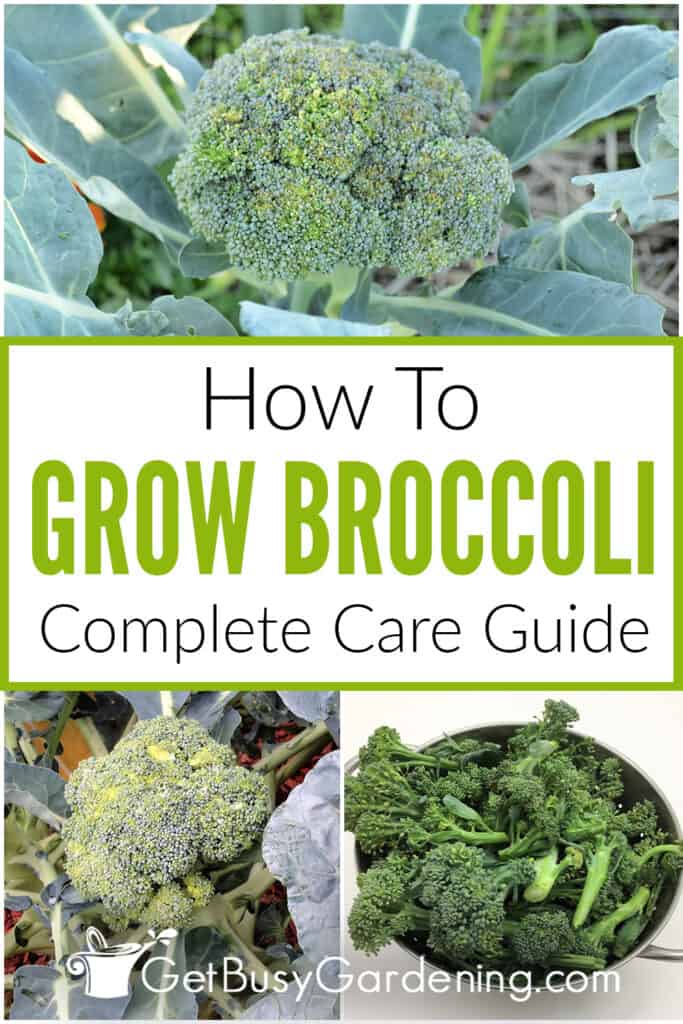



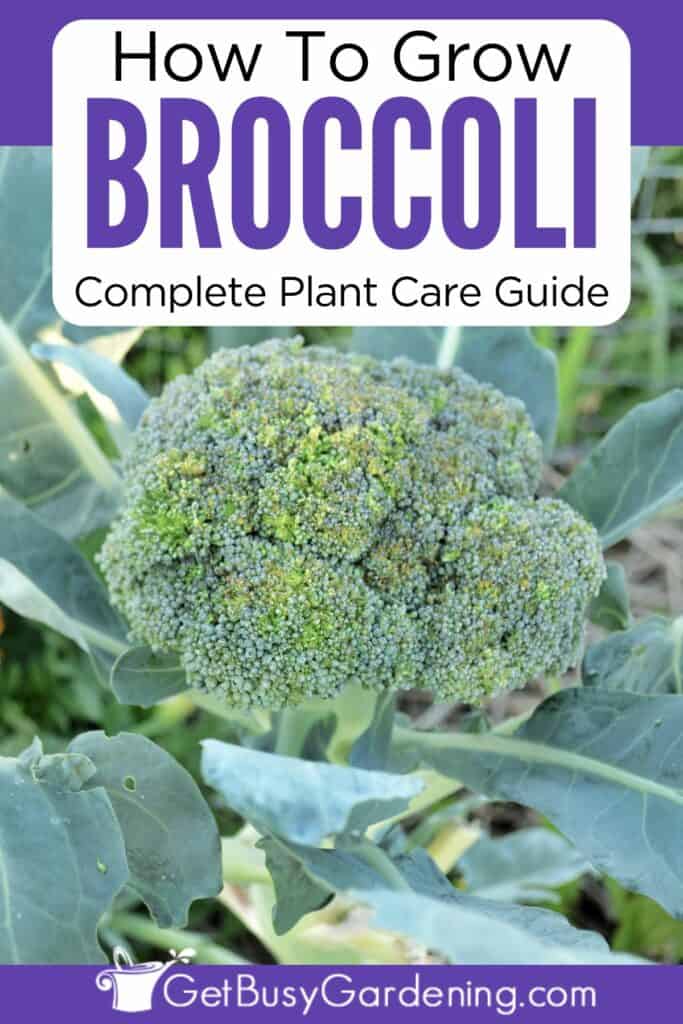

Leave a Reply